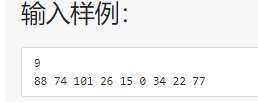如何把c#输入变成一行格式
本文共 448 字,大约阅读时间需要 1 分钟。
最近刷了一些算法题 然后我用的是c#
有的题目的输入和c#自带的输入方式不同 c#输入默认为回车另起一行 我们按照一行输入就会报异常 这样就和有的题的输入个数不同 比如下面这样
所以必须我们自己把输入格式改成一行输入这样模式
string inputStr = Console.ReadLine(); //读输入的多个连续数字 int[] nums = new int[3]; string[] numsStr = inputStr.Split(' '); //用空格分割字符串 for (int i = 0; i < numsStr.Length ; i++) { nums[i] = Convert.ToInt32(numsStr[i]); //字符串转数字 } //nums里边就是输入的数字 这样修改输入之后即可达到我们想要的一行输入的效果
Convert.ToDecimal(“0.33333333”).ToString(“0.00”);转载地址:http://vsqtz.baihongyu.com/
你可能感兴趣的文章
nginx net::ERR_ABORTED 403 (Forbidden)
查看>>
Nginx SSL私有证书自签,且反代80端口
查看>>
Nginx upstream性能优化
查看>>
Nginx 中解决跨域问题
查看>>
nginx 代理解决跨域
查看>>
Nginx 动静分离与负载均衡的实现
查看>>
Nginx 反向代理 MinIO 及 ruoyi-vue-pro 配置 MinIO 详解
查看>>
nginx 反向代理 转发请求时,有时好有时没反应,产生原因及解决
查看>>
Nginx 反向代理解决跨域问题
查看>>
Nginx 反向代理配置去除前缀
查看>>
nginx 后端获取真实ip
查看>>
Nginx 多端口配置和访问异常问题的排查与优化
查看>>
Nginx 如何代理转发传递真实 ip 地址?
查看>>
Nginx 学习总结(16)—— 动静分离、压缩、缓存、黑白名单、性能等内容温习
查看>>
Nginx 学习总结(17)—— 8 个免费开源 Nginx 管理系统,轻松管理 Nginx 站点配置
查看>>
Nginx 学习(一):Nginx 下载和启动
查看>>
nginx 常用指令配置总结
查看>>
Nginx 常用配置清单
查看>>
nginx 常用配置记录
查看>>
nginx 开启ssl模块 [emerg] the “ssl“ parameter requires ngx_http_ssl_module in /usr/local/nginx
查看>>